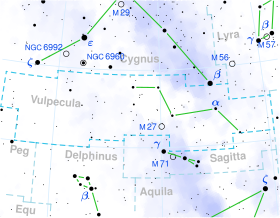29 Vulpeculae
| Observation data Epoch J2000 Equinox J2000 | |
|---|---|
| Constellation | Vulpecula |
| Right ascension | 20h 38m 31.32904s[1] |
| Declination | 21° 12′ 04.3763″[1] |
| Apparent magnitude (V) | 4.82[2] |
| Characteristics | |
| Spectral type | A0V[3] |
| U−B color index | −0.07[2] |
| B−V color index | −0.02[2] |
| Astrometry | |
| Radial velocity (Rv) | −17.10[4] km/s |
| Proper motion (μ) | RA: +78.741[1] mas/yr Dec.: −4.572[1] mas/yr |
| Parallax (π) | 15.6257 ± 0.3374[1] mas |
| Distance | 209 ± 5 ly (64 ± 1 pc) |
| Absolute magnitude (MV) | 0.56[5] |
| Details | |
| Mass | 2.67[3] M☉ |
| Luminosity | 71[3] L☉ |
| Surface gravity (log g) | 4.20[6] cgs |
| Temperature | 10,507[6] K |
| Metallicity [Fe/H] | −0.15[5] dex |
| Rotational velocity (v sin i) | 52[3] km/s |
| Age | 254[6] Myr |
| Other designations | |
| Database references | |
| SIMBAD | data |
29 Vulpeculae is a suspected astrometric binary star system in the northern constellation Vulpecula. It is visible to the naked eye as a faint, white-hued point of light with an apparent visual magnitude of 4.82.[2] The system lies approximately 209 light years away from the Sun based on parallax,[1] and is a member of the IC 2391 supercluster.[8] It is moving closer to the Earth with a heliocentric radial velocity of −17 km/s.[4]
Radial velocity measurements from High Accuracy Radial Velocity Planet Searcher with an amplitude of 4 km/s indicate that it is a spectroscopic binary of unknown period.[9] The visible component is an A-type main-sequence star with a stellar classification of A0V,[3] and has some slight abundance anomalies that resemble a weak Am star.[10] It is catalogued as a shell star, showing spectral features of a cooler circumstellar jacket of gas,[11] and may be a proto-shell star.[10] The star is an estimated 254[6] million years old with a relatively low projected rotational velocity of 52 km/s.[3] It has 2.67[3] times the mass of the Sun and is radiating 71[3] times the Sun's luminosity from its photosphere at an effective temperature of 10,507 K.[6]
References[]
- ^ a b c d e f Brown, A. G. A.; et al. (Gaia collaboration) (August 2018). "Gaia Data Release 2: Summary of the contents and survey properties". Astronomy & Astrophysics. 616. A1. arXiv:1804.09365. Bibcode:2018A&A...616A...1G. doi:10.1051/0004-6361/201833051. Gaia DR2 record for this source at VizieR.
- ^ a b c d Ducati, J. R. (2002). "VizieR Online Data Catalog: Catalogue of Stellar Photometry in Johnson's 11-color system". CDS/ADC Collection of Electronic Catalogues. 2237. Bibcode:2002yCat.2237....0D.
- ^ a b c d e f g h Zorec, J.; Royer, F. (2012). "Rotational velocities of A-type stars". Astronomy & Astrophysics. 537: A120. arXiv:1201.2052. Bibcode:2012A&A...537A.120Z. doi:10.1051/0004-6361/201117691. S2CID 55586789. Vizier catalog entry
- ^ a b Gontcharov, G. A. (2006). "Pulkovo Compilation of Radial Velocities for 35 495 Hipparcos stars in a common system". Astronomy Letters. 32 (11): 759–771. arXiv:1606.08053. Bibcode:2006AstL...32..759G. doi:10.1134/S1063773706110065. S2CID 119231169.
- ^ a b Anderson, E.; Francis, Ch. (2012). "XHIP: An extended hipparcos compilation". Astronomy Letters. 38 (5): 331. arXiv:1108.4971. Bibcode:2012AstL...38..331A. doi:10.1134/S1063773712050015. S2CID 119257644. Vizier catalog entry
- ^ a b c d e David, Trevor J.; Hillenbrand, Lynne A. (2015). "The Ages of Early-Type Stars: Strömgren Photometric Methods Calibrated, Validated, Tested, and Applied to Hosts and Prospective Hosts of Directly Imaged Exoplanets". The Astrophysical Journal. 804 (2): 146. arXiv:1501.03154. Bibcode:2015ApJ...804..146D. doi:10.1088/0004-637X/804/2/146. S2CID 33401607. Vizier catalog entry
- ^ "29 Vul". SIMBAD. Centre de données astronomiques de Strasbourg. Retrieved 2019-03-17.
- ^ Eggen, Olin J. (December 1995), "Reality Tests of Superclusters in the Young Disk Population", Astronomical Journal, 110: 2862, Bibcode:1995AJ....110.2862E, doi:10.1086/117734.
- ^ Borgniet, S.; Lagrange, A.-M.; Meunier, N.; Galland, F. (2017). "Extrasolar planets and brown dwarfs around AF-type stars". Astronomy and Astrophysics. 599. A57. arXiv:1608.08257. Bibcode:2017A&A...599A..57B. doi:10.1051/0004-6361/201628805. S2CID 118723455.
- ^ a b Adelman, Saul J.; Albayrak, Berahitdin (October 1998). "Elemental abundance analyses with DAO spectrograms - XX. The early A stars epsilon Serpentis, 29 Vulpeculae and sigma Aquarii". Monthly Notices of the Royal Astronomical Society. 300 (2): 359–372. Bibcode:1998MNRAS.300..359A. doi:10.1046/j.1365-8711.1998.01859.x.
- ^ Hauck, B.; Jaschek, C. (February 2000). "A-shell stars in the Geneva system". Astronomy and Astrophysics. 354: 157–162. Bibcode:2000A&A...354..157H.
- A-type main-sequence stars
- Shell stars
- Spectroscopic binaries
- Vulpecula
- Durchmusterung objects
- Flamsteed objects
- Henry Draper Catalogue objects
- Hipparcos objects
- HR objects
